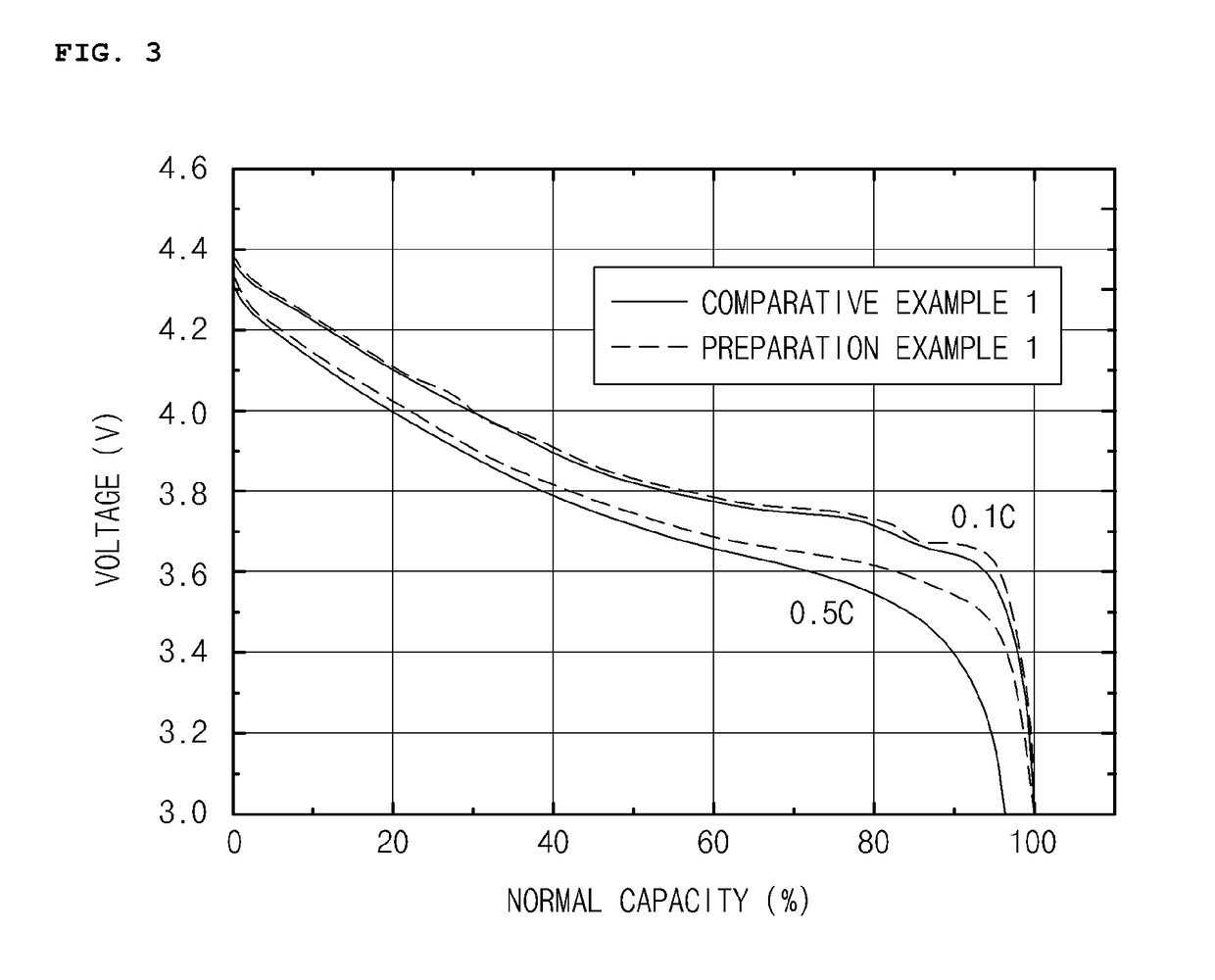Positive electrode active material for lithium secondary battery, method of preparing the same and lithium secondary battery including the same
a lithium secondary battery and active material technology, applied in the manufacture process of electrodes, cell components, electrochemical generators, etc., can solve the problems of lithium secondary batteries with limitations, deterioration of initial capacity properties, and rapid decrease in life of lithium secondary batteries, so as to increase the transport rate of lithium ions, good rate characteristics and life properties, the effect of reducing the initial capacity property
- Summary
- Abstract
- Description
- Claims
- Application Information
AI Technical Summary
Benefits of technology
Problems solved by technology
Method used
Image
Examples
preparation example 1
ve Electrode Active Material
[0100]A Li2CO3 powder and a Co3O4 powder were mixed in certain amounts such that a Li / Co molar ratio was 0.95, followed by first heating at 900° C. for 10 hours. The powder thus obtained was ground and screened to prepare lithium deficient first lithium cobalt oxide particles.
[0101]The first lithium cobalt oxide particles thus prepared was dry mixed with a Li2CO3 powder and a Co3O4 powder in certain amounts such that a Li / Co molar ratio was 1.01, followed by second heating at 1,050° C. for 20 hours to prepare a positive electrode active material (Average particle diameter: 12 μm) with a monolith structure, in which lithium was distributed with an increasing concentration gradient from the center to the surface of a particle over the whole positive electrode active material.
preparation example 2
ve Electrode Active Material
[0102]A Li2CO3 powder and a Co3O4 powder were mixed in certain amounts such that a Li / Co molar ratio was 0.95, followed by first heating at 900° C. for 10 hours. The powder thus obtained was ground and screened to prepare lithium deficient first lithium cobalt oxide particles.
[0103]The first lithium cobalt oxide particles thus prepared was dry mixed with a Li2CO3 powder and a Co3O4 powder in certain amounts such that a Li / Co molar ratio was 1, followed by second heating at 900° C. for 20 hours to prepare a positive electrode active material (Average particle diameter: 12 μm) with a monolith structure including second lithium cobalt oxide (LibCoO2, b=1) on the surface of the core particle of the first lithium cobalt oxide (Li1-aCoO2, a=0.95). In this case, thickness of the shell part including the second lithium cobalt oxide was 250 nm.
preparation example 3
ve Electrode Active Material
[0104]A Li2CO3 powder and a Co3O4 powder were mixed in certain amounts such that a Li / Co molar ratio was 0.95, followed by first heating at 900° C. for 10 hours. The powder thus obtained was ground and screened to prepare lithium deficient first lithium cobalt oxide particles.
[0105]The first lithium cobalt oxide particles thus prepared was dry mixed with a Li2CO3 powder and a Co3O4 powder in certain amounts such that a Li / Co molar ratio was 1, and MgO and TiO2 powders were additionally added in certain amounts such that each of Mg and Ti metals is 0.01 mol with respect to 1 mol of Li, followed by second heating at 1,050° C. for 20 hours to prepare a positive electrode active material (Average particle diameter: 12 μm) with a monolith structure, in which lithium is distributed with a concentration gradient gradually increasing from the center to the surface of a particle over the whole positive electrode active material and including lithium cobalt oxide d...
PUM
| Property | Measurement | Unit |
|---|---|---|
| molar ratio | aaaaa | aaaaa |
| particle diameter | aaaaa | aaaaa |
| voltage | aaaaa | aaaaa |
Abstract
Description
Claims
Application Information
 Login to View More
Login to View More - R&D
- Intellectual Property
- Life Sciences
- Materials
- Tech Scout
- Unparalleled Data Quality
- Higher Quality Content
- 60% Fewer Hallucinations
Browse by: Latest US Patents, China's latest patents, Technical Efficacy Thesaurus, Application Domain, Technology Topic, Popular Technical Reports.
© 2025 PatSnap. All rights reserved.Legal|Privacy policy|Modern Slavery Act Transparency Statement|Sitemap|About US| Contact US: help@patsnap.com



